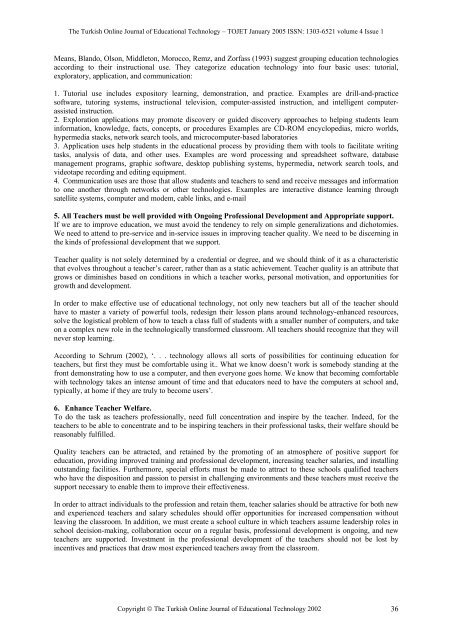Age - TOJET the Turkish online journal of educational technology
Age - TOJET the Turkish online journal of educational technology
Age - TOJET the Turkish online journal of educational technology
You also want an ePaper? Increase the reach of your titles
YUMPU automatically turns print PDFs into web optimized ePapers that Google loves.
The <strong>Turkish</strong> Online Journal <strong>of</strong> Educational Technology – <strong>TOJET</strong> January 2005 ISSN: 1303-6521 volume 4 Issue 1<br />
Means, Blando, Olson, Middleton, Morocco, Remz, and Zorfass (1993) suggest grouping education technologies<br />
according to <strong>the</strong>ir instructional use. They categorize education <strong>technology</strong> into four basic uses: tutorial,<br />
exploratory, application, and communication:<br />
1. Tutorial use includes expository learning, demonstration, and practice. Examples are drill-and-practice<br />
s<strong>of</strong>tware, tutoring systems, instructional television, computer-assisted instruction, and intelligent computerassisted<br />
instruction.<br />
2. Exploration applications may promote discovery or guided discovery approaches to helping students learn<br />
information, knowledge, facts, concepts, or procedures Examples are CD-ROM encyclopedias, micro worlds,<br />
hypermedia stacks, network search tools, and microcomputer-based laboratories<br />
3. Application uses help students in <strong>the</strong> <strong>educational</strong> process by providing <strong>the</strong>m with tools to facilitate writing<br />
tasks, analysis <strong>of</strong> data, and o<strong>the</strong>r uses. Examples are word processing and spreadsheet s<strong>of</strong>tware, database<br />
management programs, graphic s<strong>of</strong>tware, desktop publishing systems, hypermedia, network search tools, and<br />
videotape recording and editing equipment.<br />
4. Communication uses are those that allow students and teachers to send and receive messages and information<br />
to one ano<strong>the</strong>r through networks or o<strong>the</strong>r technologies. Examples are interactive distance learning through<br />
satellite systems, computer and modem, cable links, and e-mail<br />
5. All Teachers must be well provided with Ongoing Pr<strong>of</strong>essional Development and Appropriate support.<br />
If we are to improve education, we must avoid <strong>the</strong> tendency to rely on simple generalizations and dichotomies.<br />
We need to attend to pre-service and in-service issues in improving teacher quality. We need to be discerning in<br />
<strong>the</strong> kinds <strong>of</strong> pr<strong>of</strong>essional development that we support.<br />
Teacher quality is not solely determined by a credential or degree, and we should think <strong>of</strong> it as a characteristic<br />
that evolves throughout a teacher’s career, ra<strong>the</strong>r than as a static achievement. Teacher quality is an attribute that<br />
grows or diminishes based on conditions in which a teacher works, personal motivation, and opportunities for<br />
growth and development.<br />
In order to make effective use <strong>of</strong> <strong>educational</strong> <strong>technology</strong>, not only new teachers but all <strong>of</strong> <strong>the</strong> teacher should<br />
have to master a variety <strong>of</strong> powerful tools, redesign <strong>the</strong>ir lesson plans around <strong>technology</strong>-enhanced resources,<br />
solve <strong>the</strong> logistical problem <strong>of</strong> how to teach a class full <strong>of</strong> students with a smaller number <strong>of</strong> computers, and take<br />
on a complex new role in <strong>the</strong> technologically transformed classroom. All teachers should recognize that <strong>the</strong>y will<br />
never stop learning.<br />
According to Schrum (2002), ‘. . . <strong>technology</strong> allows all sorts <strong>of</strong> possibilities for continuing education for<br />
teachers, but first <strong>the</strong>y must be comfortable using it.. What we know doesn’t work is somebody standing at <strong>the</strong><br />
front demonstrating how to use a computer, and <strong>the</strong>n everyone goes home. We know that becoming comfortable<br />
with <strong>technology</strong> takes an intense amount <strong>of</strong> time and that educators need to have <strong>the</strong> computers at school and,<br />
typically, at home if <strong>the</strong>y are truly to become users’.<br />
6. Enhance Teacher Welfare.<br />
To do <strong>the</strong> task as teachers pr<strong>of</strong>essionally, need full concentration and inspire by <strong>the</strong> teacher. Indeed, for <strong>the</strong><br />
teachers to be able to concentrate and to be inspiring teachers in <strong>the</strong>ir pr<strong>of</strong>essional tasks, <strong>the</strong>ir welfare should be<br />
reasonably fulfilled.<br />
Quality teachers can be attracted, and retained by <strong>the</strong> promoting <strong>of</strong> an atmosphere <strong>of</strong> positive support for<br />
education, providing improved training and pr<strong>of</strong>essional development, increasing teacher salaries, and installing<br />
outstanding facilities. Fur<strong>the</strong>rmore, special efforts must be made to attract to <strong>the</strong>se schools qualified teachers<br />
who have <strong>the</strong> disposition and passion to persist in challenging environments and <strong>the</strong>se teachers must receive <strong>the</strong><br />
support necessary to enable <strong>the</strong>m to improve <strong>the</strong>ir effectiveness.<br />
In order to attract individuals to <strong>the</strong> pr<strong>of</strong>ession and retain <strong>the</strong>m, teacher salaries should be attractive for both new<br />
and experienced teachers and salary schedules should <strong>of</strong>fer opportunities for increased compensation without<br />
leaving <strong>the</strong> classroom. In addition, we must create a school culture in which teachers assume leadership roles in<br />
school decision-making, collaboration occur on a regular basis, pr<strong>of</strong>essional development is ongoing, and new<br />
teachers are supported. Investment in <strong>the</strong> pr<strong>of</strong>essional development <strong>of</strong> <strong>the</strong> teachers should not be lost by<br />
incentives and practices that draw most experienced teachers away from <strong>the</strong> classroom.<br />
Copyright © The <strong>Turkish</strong> Online Journal <strong>of</strong> Educational Technology 2002 36
















